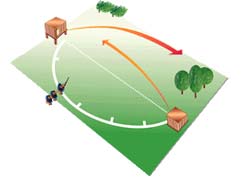SKEET SHOOTING
How to Shoot a Game of Skeet
Skeet was originally developed at the turn of the century by three men in Massachusetts. Their intention was to improve their hunting performance by recreating the flight pattern of upland birds in the field. The original game was laid out in a full circle with the shooting positions marked off like the face of a clock. Targets were thrown from a single trap positioned at 12 o’clock. It wasn’t until 1923 that the game changed to the half circle layout with two traps throwing targets. This layout made it much easier on spectators and their cars.
Field Layout
The skeet field is laid out in a semi-circle. Trap houses are located at each end of the semi-circle at the 3 o’clock and 9 o’clock positions. The trap house at the left side is called the high house. The high house throws as clay target (bird) from a height of 10 feet at a slight upward angle. The trap house on the right is called the low how. The low house throws a clay from a height of only three feet at a slightly steeper angle than the high house.
Seven shooting positions are marked off along the perimeter of the semi-circle like the lower face of a clock. The final shooting position (#8) is located at the center of the field half way between the two trap houses.
The speed and direction of the clay birds thrown from both the high house and low house are fixed. The shooter knows exactly where the target will come from, where it will go and how fast it is going at each station. Of course a windy day does change things a bit. As the shooter moves from one station to another the angle at which he or she will observe the targets will change.
Shooting Format
Skeet is played by a squad composed of typically no more than five shooters. Each shooter in the squad takes a turn at each station before the squad proceeds to the next station.
Here is how you would participate in skeet:
1. Take your place at the shooting station while the other four shooters watch.
2. Load one shell and mount your shotgun in anticipation the first target that will be thrown from the high house.
Call for a target by yelling “pull” or “bird” and take your shot at the first bird.
3. Load a second shell, mount your shotgun and call for the second target which will be thrown by the low house.
4. You will then shoot doubles if you are at stations 1, 2, 6, or 7. See the following explanation.
5. Doubles means two targets will be thrown simultaneously. One from the high house and one from the low house. At these stations load two shells,
6. mount your shotgun and call for the targets. The trick is to first shoot the target that is launched from the house that is closest to you (outgoing target) and then swing quickly to shoot the second target (incoming target).
7. At stations 3,4 and 5 the shooter will only be presented with a single target from each house. The first target will always be thrown from the high house.
8. At station 8 each shooter in the squad will shoot a high house target and then alternate to shoot a low house target.
Illustration provided by Clay Shooting Magazine
For More Information, Please Contact:
NSSA – NSCA
5931 Roft Road
San Antonio, TX 78253
For more instruction on how to play skeet and trap games, please visit:
A round of skeet is 25 shots. Four shots from stations 1, 2, 6 and 7, and two shots from stations 3,4,5 and 8. If you were counting you would see that this only adds up to 24 shots. For this reason you have one option shot. So, when you miss a bird you shoot that one again for your option. If you are perfect you get to shoot two at low eight for your option shot.
You should actually have a few more than 25 shells with you during the game. The reason being that it is common to break both birds in doubles with one shot as they cross each other. In this case you will have to shoot them over again.
Shotguns
Just about any shotgun will provide a fun experience on the skeet range. So if you are shooting primarily to improve your performance in the field you should bring your field gun. The only restrictions are a maximum of 12 gauge using shot loads not exceeding 1 1/8-ounces. Registered skeet competition is shot using four different gauges, 12, 20, 28 and .410. The 12 gauge event is open to all gauges 12 or smaller. The 20 gauge event is open to 20 gauge or smaller and so on. You do not have to shoot all four gauges to compete.
Skeet is a relatively close range game. The longest shot you will see is 27 yards. Most targets are hit between 4 and 20 yards. For this reason a shotgun capable of firing at least two shots with an open choke (light modified to skeet 1) is an asset in this game.
Skeet at the Coeur d’Alene Skeet and Trap Club
The Coeur d’Alene Skeet and Trap club has four skeet fields. We are open to the public and members Wednesday through Sunday. The club holds two league skeet shoots annually for members; the largest of which in the winter league. Please drop by and shoot a round or two of skeet with us. New shooters are welcome. Club members and staff are glad to help you learn the game.
Skeet Shooting Lesson
Todd Bender: Winning
Todd Bender Winning with the Fundamentals in Skeet
Todd Bender: Coaching
Copyright © 2019 Coeur d’Alene Skeet & Trap.



